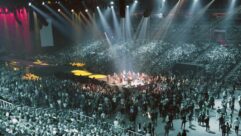A Tale of Two HallsTime, money and communication can make the difference between an acoustical disaster and an acoustical success.
Jan 20, 1997 12:00 PM,
By Leo BeranekBeranek is an acoustical design consultant based in Cambridge, MA.
The purpose of a concert hall is to provide beautiful music. If the hall presents striking architecture and makes the hall’s owners a mint of money in the process, it will be a successful concert hall. But the reason concert-goers buy their tickets is to hear the music. So why is it that the sound quality is often at the bottom of the list of priorities?
As an acoustical consultant, the author has worked on projects that accomplished all these goals and were an unqualified success. The author has worked on projects that missed the main goal – excellent sound – by a wide margin? What was the difference?
Simple: time, money and communication. If the amount of money allotted to the design process is unrealistic; if the schedule does not allow testing and tweaking of the acoustic design to achieve perfection; and if the owner, architect and acoustic consultant cannot agree on compromises that make the most of sound, image and finances, the project will not meet everyone’s expectations.
To show how different design processes can be and how drastically such decisions can affect the outcome, here are two examples: Lincoln Center’s Philharmonic Hall, which was built under deadline pressure with complete disregard for the acoustical consultant’s recommendations; and Tokyo’s Opera City National Theater, which was built with the cooperation of the architect and acoustical consultant and allowed time enough to build a scale model and do a year’s worth of acoustical testing before opening. In these design processes, it was time, money and communication that made the difference between an acoustical disaster and an acoustical success.
Lincoln CenterLincoln Center for the Performing Arts was incorporated in June 1956, dedicated to fostering the arts of music, dance and drama and to encouraging the public enjoyment of those arts. Its board of directors comprised corporate leaders, philanthropists and representatives of the center’s constituents, and the board’s duties were staggering. Lincoln Center started with no financial resources. Over a period of 20 years, the center was constantly raising money, ultimately reaching $179 million, of which 70% came from individuals and foundations, 6% from corporations and 24% from various government entities. The Lincoln Center board had to persuade and prepare contracts with its constituents and with the government of New York State. Finally, it had to commission architects, choose contractors, approve plans and costs and supervise construction.
Five buildings were constructed: the Metropolitan Opera House, the Philharmonic Concert Hall, the New York State Theater, an addition to the Julliard School, and the Vivian Beaumont Theatre, to which was attached a Library-Museum. The total cost of the buildings was about $152 million, each with a different architect.
The design of the Philharmonic HallThe Philharmonic Hall was modeled after Boston Symphony Hall, with certain acoustical characteristics: a rectangular form; shallow balconies with floors paralleling the shape of the main floor below; a 2,400-person seating capacity; reverberation time of not less than 1.9 s; a few suspended panels over the orchestra and front rows of seats to enhance communication amongst the members of the orchestra and to provide early sound reflections to the front rows of seats; large-scale diffusing irregularities on the ceiling, walls and balcony fronts; and no thin wood in order to preserve the bass tones.
The architect for Philharmonic Hall was Max Abramovitz of Harrison & Abramovitz. He selected Bolt, Beranek & Newman (BBN) as the acoustical consultant.
The architect designed the hall to meet these specifications. In October 1959, Leo Beranek was asked to publish the details of the design in Lincoln Center’s own magazine, The Performing Arts, Volume 1, No. 10.
Reginald Allen, executive director of operations, said to Beranek, “We know there will be some objection to the hall’s seating capacity of only 2,400, but we will stand by this design because we want a top quality hall.” On Dec. 2, 1959, following a press conference called by the architect and Lincoln Center, The New York Times ran a descriptive article on the hall and printed an architect’s rendering that agreed with the magazine article.
After the Times article, the newspapers of New York were harshly negative, complaining that the hall would have only 2,400 seats compared to 2,760 in Carnegie Hall. The Board and Building Committee, forgetting its previous statement of resolve, ordered the architect to accommodate another 250 seats. The foundations for the building were already being poured, so all changes had to take place inside the hall. Instead of making the seats narrower (they were very large for that time) and the row-to-row spacing less, as the acoustical consultant urged, the architect chose to change the balconies. On either side of the hall, the balconies were made to swoop downward, the rear part opening on one floor and the front part on the floor below. This was the most serious source of complaint in the hall when built.
The architect was unhappy about the appearance of a few hanging panels in the front of the hall and requested that they be extended over a large percentage of the ceiling area. BBN only had experience with hanging panels in two halls where they were over the front, and so did not object to the larger array. But BBN took precautions in case the larger array didn’t work. The architect asked that each row of panels be installed so that their height could be adjusted instantly by electric motors. That way, the extra panels could be pulled up to the ceiling if they gave trouble.
The architect also wanted each successive row to set up from the row in front rather than designing the panel array to lie in one continuous surface as in the Tanglewood Music Shed. This, too, BBN did not object to because the architect agreed that the panels would be adjustable so their tilt could be changed and they could be aligned into a single plane with the electric motors. There was no time to build and test a model to find any hidden dangers.
But then came the disaster. Only a few months before the construction of the interior was completed, the Building Committee ordered the architect to cut the cost of construction, and this was only possible by removing all the irregularities from the walls and ceiling, which would make them perfectly smooth, and eliminating the motors for adjusting the heights of the panel rows.
Philharmonic Hall after the openingFollowing the opening of the hall, the three principle complaints were that low-frequency sound was lacking in the audience, the high-frequency sound had a shrill or strident quality, and some echoes could be heard by the musicians seated at stage center.
BBN built a scale model of the panel array and showed that if the panels were adjusted to lie in a smooth plane, the bass response of the hall would be greatly improved. The shrill quality of the high frequencies could only be eliminated by adding extensive diffusing elements on the side walls and balcony fronts. The echoes might be reduced by addition of some acoustical sound-absorbing material.
Instead of proceeding with BBN’s recommendations, the president of Lincoln Center, William Schuman, panicked and instructed the architect to engage a panel of acoustical consultants. Two were selected from Germany and two from the United States. They paid no attention to BBN’s recommendations. Over a period of three years, the consultants eliminated the panels, sloped the ceiling down lower over the stage, and added some diffusing irregularities to the side walls. But, because of the sloping balcony fronts, the sound was not evenly distributed, and the echo was not eliminated. Complaints continued.
Finally, Lincoln Center, with funding from the philanthropist Avery Fisher, decided to tear out the sloping balconies and shape then like those in Symphony Hall. Major irregularities were then introduced on all interior surfaces of the hall. The stage was made to resemble those in other successful halls. Finally, the ceiling was lowered, which reduced the full-house, mid-frequency reverberation time from 2.0 s to 1.75 s. Because 1.9 s to 2.0 s is optimum for a concert hall, Avery Fisher Hall still does not equal the world’s best in this respect, but it is greatly improved.
Tokyo’s Opera City’s National TheaterThe 11 acre (4.4 hectares) plot on which this performing arts center of Tokyo is being built has two owners: the Japanese Art Council of the national government owns 6 acres, and a consortium of private companies represented by The Executive Committee for Construction and Management of Tokyo Opera City owns 5 acres. The buildings include a western-style opera house, a concert hall, a drama theater, an experimental theater, rehearsal halls, an art gallery, a 54-story skyscraper, a sunken garden, shops, offices and research facilities.
Each owner has a separate building committee; the committee members have vested the design and construction process completely in the hands of the architects. Because the concert hall, Tokyo Opera City (TOC), is owned by the executive committee of TOC, the architect is a joint-venture design team led by TAK Associated Architects, with architect Takahiko Yangisawa in charge. The acoustical consultant is the Acoustical Laboratory of the Takenaka Research and Development Institute of China, in association with the author, an acoustical design consultant. The initial shape and appearance of the concert hall was set before the author was retained as acoustical design consultant, but modifications to the design were permissible if deemed necessary.
The hall is rectangular in plan, but it differs from the classical shoe-box halls in that its ceiling has the shape of a distorted pyramid, truly a novel design.
The acoustical consultants recommended a computer-aided design (CAD) of a model of the hall, and the acoustical waves radiated by the virtual source were reflected from the CAD surfaces of the hall and detected by a receiver. With this procedure, the direction of the waves, their energy and any echoes could be determined. Because the CAD model could easily be modified, it was possible to shape the surfaces and reflecting canopy to achieve uniform distribution of the sound energy over the audience and to estimate the spaciousness at each location. Spaciousness is related to the sound energy arriving at a location from early lateral reflections compared to the energy arriving from the direction of the source. For best listener satisfaction, this ratio should be as high as possible. From calculations, the cubic volume, i.e., the height of the hall, could be set to give the desired reverberation time, which was specified to exceed 1.9 s.
When the architect was fairly certain of his design, a 10:1 scale model was made. With it the results of the computer model could be confirmed and further refinements adopted. Tiny loudspeakers were placed on the stage, and listeners were simulated by 2 cm diameter “heads” with two tiny microphones as ears. With the a scale model, the six primary acoustical features important to a listening audience – spaciousness, clarity, liveness, bass response, intimacy and diffusivity – could be measured. The difference between its results and those from the CAD model is that the study of the scale model can accurately represent the seats, with and without occupants, and can introduce diffraction and diffusion by nonsmooth surfaces. Also, with the scale model, the frequency balance could be estimated.
The consultants and the architect arranged and planned for test concerts, with captive audience, well in advance of the opening of the hall. Acoustical conditions that could not be determined from the models were experienced in the real hall. These include how well musicians hear each other on stage, how they perceive the response of the hall to their playing and whether there are any previously undetected echoes. It was found that some of the materials in the hall absorbed or reflected sound differently from the materials used in the 10:1 model. Finally, the seats, with audience, absorbed sound differently than measured in the 10:1 model and in the laboratory. To make the necessary adjustments, additional acoustical materials were added to the room at particular locations to improve the acoustical balance. If drastically different results for seat sound absorption had been obtained, sufficient time remained for their modification, but that was not necessary.
From the first of two test concerts, it appears that the Tokyo Opera City Concert Hall will receive favorable acceptance. Its opening will be in September 1997.
ContrastsIt is apparent that the success of a project depends on clearly defined and unchanging goals by the owners of the halls and all of their appointed building committees.
Second, a successful result in the design of a concert hall of unique shape requires that nothing be left to chance. A CAD computer model and a scale model of the hall as it is to be built should be made and thoroughly tested. Laboratory tests should be performed on the individual components before their installation in the hall: the sound absorption of seats, the reflectivity of suspended panels or canopy, the diffusivity of surfaces of the hall and the absorption of all surface materials.
Money must be available to make any necessary corrections after the test concerts and after the final opening. Finally, the owner must understand that any changes that might seem desirable after opening should be made slowly and after careful testing to ensure that satisfactory results will be obtained.
It is in these respects that the Tokyo and New York projects have differed greatly and have resulted in vastly differing outcomes.










